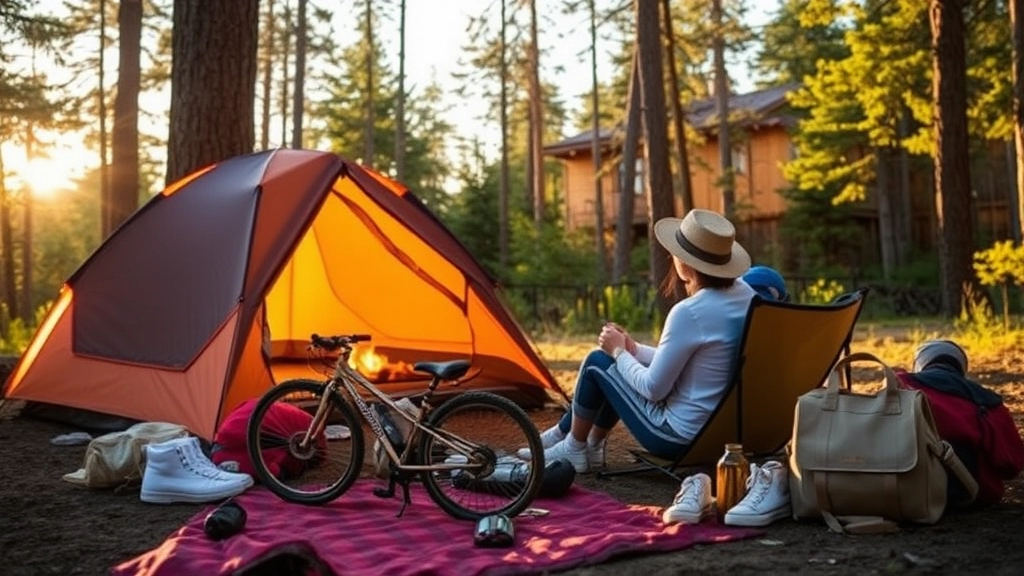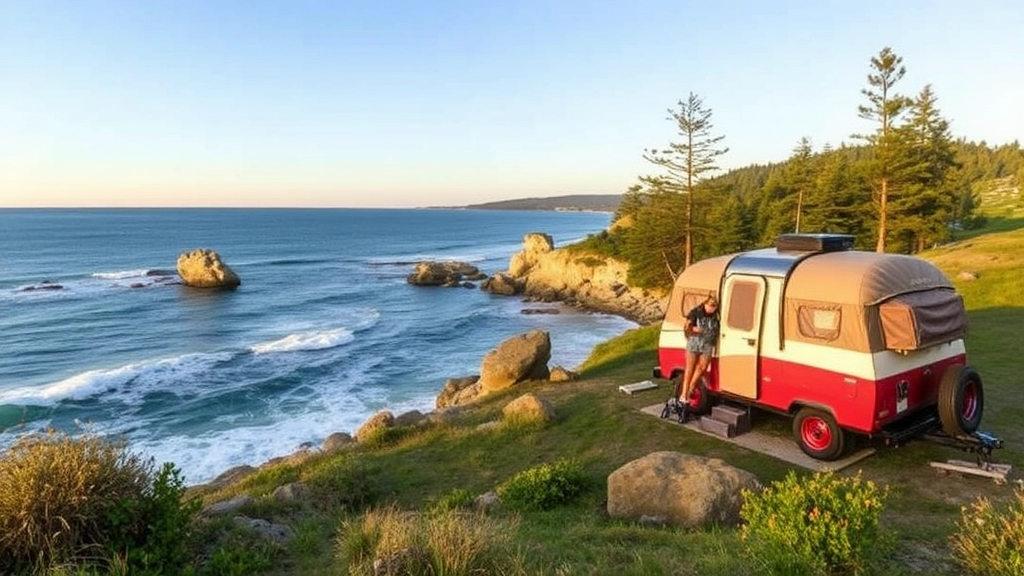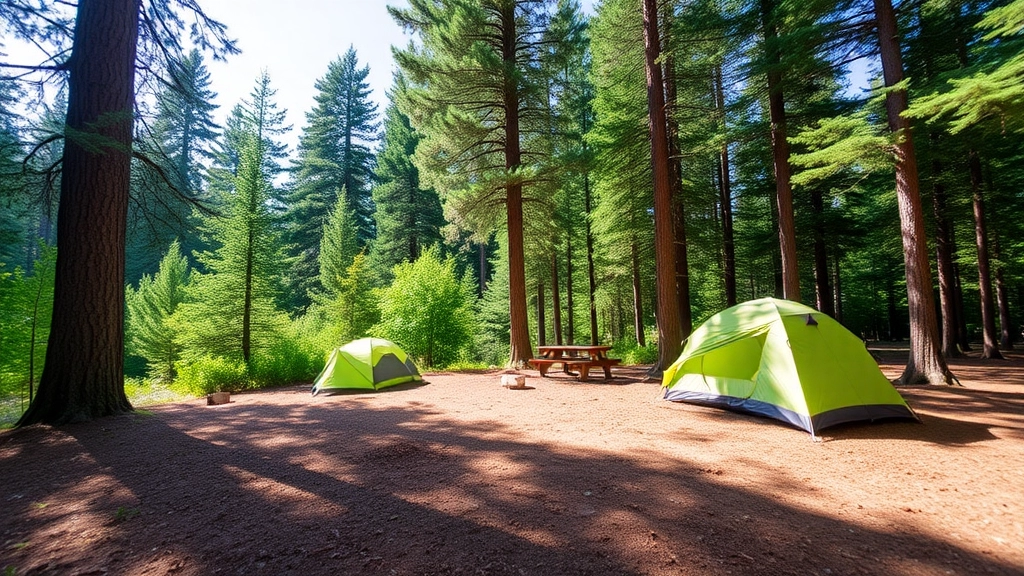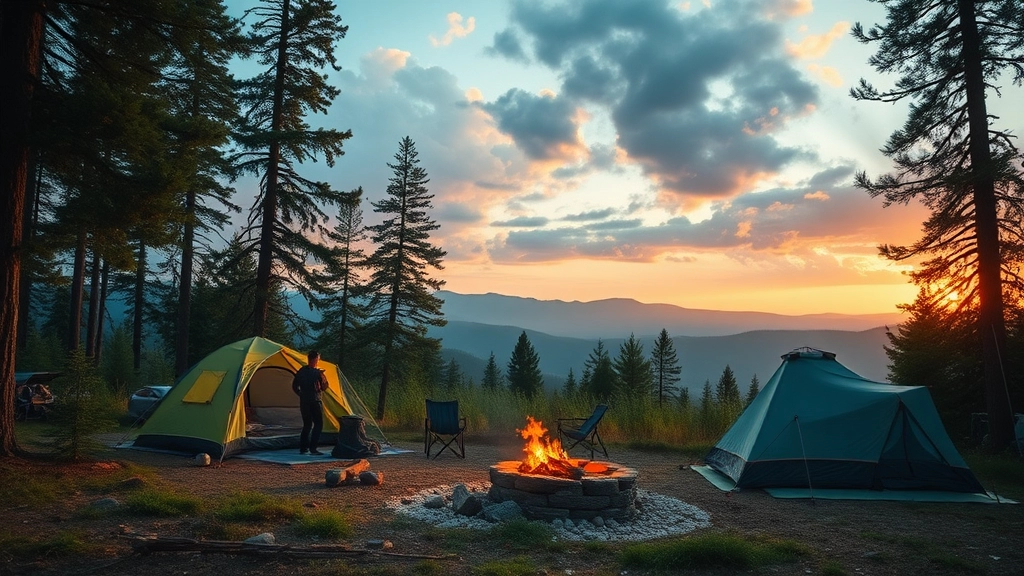Escape the Summer Heat
Ever dreamt of escaping the sweltering summer heat while still enjoying the great outdoors? Cool weather camping in summer might just be your perfect getaway. This guide will walk you through the best destinations for cool weather camping, essential gear to beat the heat, tent selection tips, and activities to
Best Destinations for Cool Weather Camping in Summer
Ever tried camping in the summer only to find yourself sweating buckets and struggling to sleep? Yeah, me too. Let’s talk about the best destinations for cool weather camping in summer. Trust me, finding the right spot can make all the difference between a miserable trip and a refreshing adventure.
Why Cool Weather Camping?
First off, why bother with cool weather camping? Simple. It’s about comfort, better sleep, and avoiding that sticky, humid mess that makes you feel like you’re in a sauna. Plus, cooler climates often come with stunning landscapes and fewer bugs. Win-win, right?
Top Picks for Cool Weather Camping
Here are my go-to spots for cool weather camping:
-
Scottish Highlands, Scotland
- Why it’s cool: High altitudes and northern latitude keep things chilly.
- What to do: Hike the Cairngorms, explore Loch Ness, and enjoy the stunning vistas.
-
Lake District, England
- Why it’s cool: Elevation and frequent breezes.
- What to do: Boat on Windermere, hike Scafell Pike, and just soak in the beauty.
-
Snowdonia, Wales
- Why it’s cool: Mountainous terrain keeps the temps down.
- What to do: Climb Mount Snowdon, explore the slate caverns, and enjoy panoramic views.
-
Peak District, England
- Why it’s cool: Rolling hills and valleys create a natural air conditioner.
- What to do: Walk the Pennine Way, visit Chatsworth House, and enjoy the serene landscapes.
Tips for Finding Cool Camping Spots
- Elevation is your friend: Higher altitudes generally mean cooler temperatures.
- Check the latitude: Northern locations often stay cooler.
- Look for shade: Forested areas can provide natural cooling.
- Proximity to water: Lakes and rivers can help moderate temperatures.
Real Talk: What to Expect
Camping in cooler climates isn’t just about beating the heat; it’s about experiencing nature in a whole new way. Imagine waking up to crisp morning air, sipping coffee with a view that takes your breath away, and sleeping soundly without sweating through your sleeping bag. Sounds good, right?
For more tips on making your summer camping experience enjoyable, check out our summer camping checklist and ensure you have all the summer camp essentials packed for your trip.
Gear Essentials to Beat the Heat While Camping

Ever tried sleeping in a tent when it’s hotter than a sauna? Not fun, right?
Let’s dive into the gear essentials to beat the heat while camping.
Why Does It Get So Hot?
First off, why does it get so hot when you’re camping?
It’s because tents can trap heat like you wouldn’t believe.
But don’t worry; I’ve got your back.
Must-Have Gear
Here’s what you need:
- Cooling Pad or Mat: These are lifesavers. They keep you cool from the bottom up. No more waking up in a pool of sweat.
- Portable Fan: Battery-operated fans are a game-changer. Some even come with misters. Imagine a mini breeze right in your tent!
- Reflective Sunshade: Put this over your tent. It reflects sunlight and keeps your tent cooler.
- Light-Coloured Tent: Dark colours absorb heat. Go for something light to keep things breezy inside.
- Hydration Pack: Staying hydrated is key. A hydration pack makes it easy to sip water while you hike.
Real Talk: My Experience
I once camped in the Lake District during a heatwave.
I had my cooling pad, portable fan, and reflective sunshade.
Guess what? I slept like a baby while my mates were tossing and turning.
Extra Tips
- Ventilation: Open up all the vents in your tent. Let that air flow.
- Wet Towel Trick: Drape a wet towel over your fan. Instant cool breeze.
- Frozen Water Bottles: Use them as ice packs. They’ll keep you cool and provide drinking water as they melt.
Tent Selection for Maximum Comfort in Warm Climates
Alright, let’s talk tents. When the sun’s blazing and you’re out there trying to enjoy nature, the last thing you want is to feel like you’re roasting in an oven. So, how do you pick the right tent for warm weather camping? Here are some real questions and worries you might have:
- “How do I keep my tent cool during the day?”
- “What tent materials work best for hot weather?”
- “Are there specific features I should look for in a warm-weather tent?”
Let’s break it down.
Key Features for Warm-Weather Tents
Ventilation is King
If your tent doesn’t breathe, neither will you. Look for tents with:
- Large mesh windows: These allow for maximum airflow.
- Multiple vents: Roof vents and ground vents can create a nice cross-breeze.
- Double doors: Extra entry points mean more ways for air to circulate.
Material Matters
Not all tent fabrics are created equal. For hot weather:
- Lightweight, breathable fabrics are your best friends. Think nylon or polyester.
- UV-resistant coatings can help keep the interior cooler by reflecting sunlight.
Colour Counts
Believe it or not, the colour of your tent can make a difference:
- Light-coloured tents reflect sunlight and stay cooler.
- Dark-coloured tents absorb heat, turning your shelter into a sauna.
Rainfly or No Rainfly?
In warm climates, you might think you don’t need a rainfly. But:
- A rainfly with ventilation can provide shade without stifling airflow.
- Removable rainflies give you flexibility. Keep it off when it’s dry, slap it on if it rains.
Real-Life Example
I remember this one camping trip in the Mojave Desert. The sun was relentless, and those who had dark, poorly ventilated tents were sweating buckets. But my mate Dave? He had a light-coloured tent with massive mesh panels. While the rest of us were melting, Dave was lounging in cool comfort. Lesson learned: ventilation and colour are game-changers.
Quick Tips for Extra Comfort
- Set up in the shade: Pitch your tent under trees or use a tarp for extra coverage.
- Use a reflective sunshade: These can keep the heat off your tent.
- Opt for a tent with a high ceiling: More headroom means better airflow.
Choosing the right tent for warm climates isn’t rocket science, but it does require a bit of thought. Focus on ventilation, material, and colour, and you’ll be miles ahead in the comfort game. Trust me, when you’re chilling in a well-ventilated tent while everyone else is sweltering, you’ll be glad you did your homework.
For more tips on making your summer camping experience enjoyable, check out our Ultimate Guide to Summer Camping Essentials and explore Indoor Summer Camp Activities for Kids to keep everyone entertained.
Staying Cool with Water-Based Activities

Ever wondered how to beat the heat while camping in the summer?
You’re not alone.
Let’s dive into some water-based activities that’ll keep you cool and make your camping trip a blast.
Why Water-Based Activities?
Water is nature’s air conditioner.
When the sun’s blazing, nothing feels better than a splash or a swim.
Here’s how you can use water to your advantage:
1. Swimming
Find a lake, river, or even a swimming hole.
Why?
- It’s refreshing.
- It’s fun.
- It’s a great way to cool down fast.
2. Kayaking and Canoeing
Got access to a kayak or canoe?
Perfect.
- Paddle around and enjoy the breeze.
- Dip your hands or feet in the water whenever you need a quick cool-down.
3. Fishing
Fishing isn’t just for catching dinner.
Think about it:
- You’re near water.
- You’re staying still, conserving energy.
- You can even wade into the water to fish, cooling off in the process.
4. Water Games
Camping with kids or friends?
Try these:
- Water balloon fights.
- Splash tag.
- Floating on inflatables.
5. Snorkelling
If you’re near a clear body of water, snorkelling can be a great option.
Why?
- It’s a workout.
- It’s a way to explore underwater.
- It keeps you submerged and cool.
Quick Tips for Water Activities:
- Safety First: Always check the water’s depth and current.
- Gear Up: Bring swimsuits, life jackets, and water shoes.
- Stay Hydrated: Yes, you’re in water, but drink plenty of fluids.
Real Talk:
I remember one summer camping trip where the heat was unbearable.
We found a nearby river, and it was a game-changer.
We spent hours swimming, kayaking, and just floating around.
By the end of the day, we were refreshed and ready for a campfire.
Linking It All Together:
Water-based activities aren’t just about staying cool.
They add a whole new level of fun and adventure to your camping experience.
And let’s be honest, who doesn’t love a good swim on a hot day?
So, next time you’re planning a summer camping trip, think water.
Your future self will thank you.
Looking for more tips on staying cool while camping? Check out our sections on Choosing Coastal Campgrounds and High-Altitude Campsites for more ideas.
High-Altitude Campsites for Cooler Summer Adventures
When summer hits, and the heat becomes unbearable, many of us wonder, “Where can I go to escape this scorching sun?” High-altitude campsites are your golden ticket to cooler summer adventures. Imagine waking up to crisp, refreshing air, surrounded by breathtaking mountain views. Sounds like a dream, right? Let’s dive into why high-altitude camping should be on your radar.
Why High-Altitude Campsites?
First off, high-altitude campsites naturally offer cooler temperatures. The higher you go, the cooler it gets. This is not just a theory; it’s a fact. For every 1,000 feet you climb, the temperature drops by about 3.5 degrees Fahrenheit. So, if you’re camping at 10,000 feet, you’re looking at a significant drop in temperature compared to sea level.
But it’s not just about escaping the heat. High-altitude camping also offers:
- Stunning Views: Mountains, valleys, and endless horizons.
- Less Crowds: Not everyone is up for the climb, so you get more peace and quiet.
- Unique Wildlife: Different altitudes mean different ecosystems. You might spot animals you wouldn’t see elsewhere.
Top High-Altitude Campsites
Here are some top picks for high-altitude campsites to consider:
- Rocky Mountain National Park, Colorado
- Elevation: 7,500 to 12,183 feet
- Highlights: Alpine lakes, towering peaks, and abundant wildlife.
- Denali National Park, Alaska
- Elevation: 2,000 to 20,310 feet
- Highlights: The tallest peak in North America, stunning glaciers, and diverse flora and fauna.
- Great Smoky Mountains, Tennessee/North Carolina
- Elevation: 876 to 6,643 feet
- Highlights: Lush forests, misty mountains, and rich biodiversity.
Tips for High-Altitude Camping
Now, camping at high altitudes isn’t just about packing your gear and heading out. There are some crucial things to keep in mind:
- Acclimate Slowly: Give your body time to adjust to the altitude. Spend a day or two at a mid-level elevation before heading higher.
- Stay Hydrated: High altitudes can dehydrate you faster. Drink plenty of water.
- Pack Warm Clothing: Even in summer, temperatures can drop significantly at night.
- Know the Symptoms of Altitude Sickness: Headache, nausea, dizziness. If you experience these, descend to a lower altitude immediately.
High-Altitude Gear Essentials
When it comes to gear, you need to be prepared for the unique challenges of high-altitude camping:
- High-Quality Sleeping Bag: Opt for one that’s rated for lower temperatures.
- Sturdy Tent: High-altitude winds can be fierce. A robust, wind-resistant tent is a must.
- Portable Stove: Cooking at high altitudes can be tricky. A reliable stove ensures you get your meals without hassle.
Real Stories from High-Altitude Adventures
I remember my first high-altitude camping trip to Rocky Mountain National Park. The temperature was a cool 60 degrees during the day, a welcome relief from the 90-degree heat back home. Nights were even cooler, perfect for a campfire and some stargazing. The views were nothing short of spectacular, and the serenity was unmatched.
High-altitude camping isn’t just a way to escape the heat; it’s a whole new way to experience nature. So next time you’re planning a summer camping trip, think high-altitude. You won’t regret it. For more tips on staying cool during your camping adventures, check out our essential tips for camping in summer. And if you’re looking for some fun activities to keep the kids entertained, don’t miss our summer camp science activities.
Choosing Coastal Campgrounds to Escape the Heat

Ever found yourself melting in the summer heat, wishing for a cool breeze?
Yeah, me too.
That’s why coastal campgrounds are your best bet for escaping the sweltering temperatures.
Why Coastal Campgrounds?
Simple.
The ocean’s natural air conditioning.
Here’s why you’ll love it:
- Cooler Temperatures: The sea breeze works wonders. It’s like nature’s fan, keeping you comfortable even when inland areas are baking.
- Scenic Views: Imagine waking up to the sound of waves crashing. Beats the city noise any day.
- Water Activities: From swimming to surfing, there’s no shortage of ways to stay cool and entertained.
Let’s dive into some top tips for picking the perfect coastal spot.
Top Coastal Campgrounds to Consider
- Cornwall, England
- Known for its stunning cliffs and sandy beaches.
- Perfect for hiking and exploring quaint seaside villages.
- Pembrokeshire, Wales
- Offers rugged coastlines and hidden coves.
- Ideal for kayaking and wildlife spotting.
- The Scottish Highlands
- Think dramatic landscapes and cool, crisp air.
- Great for those who love a mix of beach and mountain vibes.
What to Look For When Choosing a Coastal Campground
- Proximity to Water: The closer, the better. You’ll enjoy cooler nights and easy access to water activities.
- Shade Availability: Trees and natural cover can make a huge difference. Look for sites that offer plenty of shade.
- Amenities: Check for essentials like clean restrooms and freshwater sources. Bonus points for campgrounds with rental gear for water sports.
Packing Essentials for Coastal Camping
- Beach Gear: Towels, swimsuits, and sunblock. Don’t forget a good book for those lazy beach days.
- Light Layers: Coastal areas can get chilly at night. Pack a mix of light and warm clothing.
- Waterproof Gear: Unexpected rains can happen. A waterproof jacket and tent cover are lifesavers.
Stay Cool with These Tips
- Set Up Camp Early: Arrive early to snag the best spot with maximum shade.
- Hydrate: Keep plenty of water on hand. Dehydration can sneak up on you, especially with all the outdoor activities.
- Use a Reflective Tarp: Placing a reflective tarp over your tent can deflect some of the sun’s heat.
Real Talk: My Coastal Camping Experience
Last summer, I camped in Cornwall.
The cool breeze was a game-changer.
Every morning, I’d take a dip in the ocean, and by afternoon, I’d be exploring the coastal trails.
It was the perfect blend of relaxation and adventure.
Coastal campgrounds are your ticket to beating the summer heat.
Trust me, once you go coastal, you won’t look back.
So, pack your bags, grab your gear, and hit the coast.
Techniques for Keeping Your Campsite Cool
Ever found yourself sweating buckets in a tent, wondering why you thought summer camping was a good idea? Let’s face it, camping in the heat can be brutal. But don’t worry, I’ve got some killer tips to keep your campsite cool and comfortable. Let’s dive in.
Pick the Right Spot
First things first, location is everything. When choosing your campsite, look for:
- Shade: Trees are your best friends. They block out the sun and keep your tent cooler.
- Elevation: Higher ground tends to be cooler. Think hills and mountains.
- Water: Campsites near lakes, rivers, or streams often have cooler air.
Use Reflective Tarps
Reflective tarps can work wonders. Place them over your tent or sitting area to bounce the sun’s rays away. This simple hack can reduce the temperature inside your tent significantly.
Ventilation is Key
Proper airflow can make all the difference. Here’s how to maximise it:
- Open Windows and Vents: Most modern tents come with multiple ventilation options. Use them all.
- Set Up in a Breezy Area: If you can, position your tent where it can catch a breeze. This helps circulate the air and keeps things fresh.
Invest in Cooling Gear
You don’t need to break the bank, but a few smart purchases can keep you cool:
- Portable Fans: Battery-operated fans can be lifesavers.
- Cooling Towels: These are great for a quick cool-down.
- Ice Packs: Place them in your sleeping bag or under your pillow.
Hydrate, Hydrate, Hydrate
This might sound obvious, but staying hydrated is crucial. Drink plenty of water and keep a water bottle handy at all times. Dehydration can sneak up on you, especially when you’re active outdoors.
Timing is Everything
Avoid the midday heat by planning your activities in the early morning or late afternoon. Use the hottest part of the day to relax in the shade or take a nap.
Dress Smart
Light-coloured, loose-fitting clothing is your best bet. Opt for moisture-wicking fabrics that keep sweat away from your skin. And don’t forget your hat and sunglasses!
Keep Your Tent Cool During the Day
When you’re out exploring, make sure to:
- Cover Your Tent: Use a reflective tarp or blanket.
- Open All Vents and Windows: Let the hot air escape.
- Move Your Tent: If possible, shift it to a shadier spot.
Use Natural Resources
Nature provides some great cooling options:
- Splash in the Water: Take a dip in a nearby lake or river.
- Find Natural Shade: Large rocks or dense forest areas can offer cooler spots.
Cool Down Before Bed
A good night’s sleep is essential, so make sure you’re cool before hitting the sack:
- Take a Cool Shower: If facilities are available, a quick rinse can drop your body temperature.
- Use a Damp Cloth: Wipe yourself down with a cloth soaked in cool water.
Benefits of Camping Near Forests and Shaded Areas

Ever wondered why camping near forests and shaded areas is a game-changer for summer trips?
Let’s break it down.
Why Forests and Shade Rock for Summer Camping
First off, cooler temperatures.
Forests naturally block out the sun, making it a lot easier to stay cool.
And we all know how brutal that midday sun can be.
Real Talk: The Heat Struggle
Ever felt like you’re roasting in your tent?
Yeah, me too.
Camping in shaded areas means you won’t wake up sweating buckets.
The Perks of Natural Shade
Here’s why you should consider it:
- Temperature Control: Trees provide natural air conditioning.
- Better Sleep: Cooler temps mean better sleep quality.
- Less Gear: No need for fancy cooling gadgets.
Stories from the Trail
Last summer, I camped in a dense forest.
Guess what?
I hardly used my portable fan.
The shade kept things comfortable all day long.
How to Find the Perfect Spot
Look for:
- Dense Tree Coverage: More trees, more shade.
- Proximity to Water: Streams and lakes also help cool things down.
- Elevation: Higher spots tend to be cooler.
Quick Tips for Forest Camping
- Scout Ahead: Use maps and apps to find shaded areas.
- Arrive Early: Get the best spots before they’re taken.
- Stay Safe: Remember, forests can have critters. Keep food stored properly.
Cool Weather Camping: Clothing and Accessories to Pack
Ever found yourself sweating buckets while trying to enjoy a summer camping trip? Trust me, you’re not alone. Let’s tackle this head-on with some solid advice on what to pack for cool weather camping. This isn’t just about looking good; it’s about staying comfortable and making the most of your adventure.
Why Your Clothing Choices Matter
First off, let’s get real. The wrong clothing can turn a great trip into a sweaty nightmare. You need gear that keeps you cool during the day but also warm enough when temperatures drop at night. Here’s what you need:
Essential Clothing Items
- Breathable Layers:
- Moisture-Wicking Shirts: Keeps sweat off your skin.
- Lightweight Jackets: Perfect for those chilly mornings and evenings.
- Convertible Pants: Switch from pants to shorts in seconds.
- Headgear:
- Wide-Brimmed Hat: Keeps the sun off your face and neck.
- Bandana or Buff: Versatile and can be soaked in water for extra cooling.
- Footwear:
- Hiking Boots: Good grip and ankle support.
- Sandals: Ideal for lounging or water-based activities.
- Socks:
- Moisture-Wicking Socks: Keeps your feet dry and blister-free.
- Extra Pairs: Always good to have backups.
Accessories You Can’t Forget
- Sunglasses: Protect your eyes from UV rays.
- Hydration Pack: Staying hydrated is key.
- Cooling Towel: Drape it around your neck for instant relief.
- Portable Fan: A small, battery-operated fan can make a world of difference.
Real Talk: What I Learned the Hard Way
I remember my first summer camping trip. I packed heavy, non-breathable clothing and thought I was prepared. Big mistake. I sweated through everything and couldn’t sleep because I was so uncomfortable. Lesson learned: pack smart, not heavy.
Packing Checklist
Here’s a quick checklist to make sure you’re covered:
- Moisture-wicking shirts
- Lightweight jacket
- Convertible pants
- Wide-brimmed hat
- Bandana or buff
- Hiking boots and sandals
- Moisture-wicking socks
- Sunglasses
- Hydration pack
- Cooling towel
- Portable fan
For more tips on essential gear, check out our Summer Camping Checklist. And if you’re looking for fun activities to keep you entertained, don’t miss our guide on Summer Camp Game Ideas.
Popular Summer Campgrounds with Cooler Nighttime Temperatures
Ever found yourself tossing and turning in your tent, sweating buckets through a hot summer night?
Yeah, me too.
You’re here because you want to avoid that nightmare.
So, let’s dive into some popular summer campgrounds where the nighttime temps are actually cool.
Why Cooler Nights Matter
Cooler nights mean better sleep.
Better sleep means more energy for hiking, kayaking, or just chilling by the campfire.
Here’s where you can find those sweet, cool evenings.
High-Altitude Havens
First up, high-altitude campsites.
The higher you go, the cooler it gets.
Rocky Mountain National Park in Colorado is a prime example.
- Elevation: Over 7,500 feet
- Night Temps: Often drop to 10-15°C
Yosemite National Park in California also offers cooler nights thanks to its elevation.
- Elevation: Around 4,000 feet
- Night Temps: Can dip to 10°C in summer
Coastal Cool Spots
Next, let’s talk about coastal campgrounds.
The ocean breeze is your best friend here.
Big Sur in California is a gem.
- Night Temps: Typically around 12-15°C
- Bonus: Stunning ocean views
Acadia National Park in Maine is another coastal beauty.
- Night Temps: Hover around 10-15°C
- Bonus: Gorgeous sunrise views
Forested Retreats
Camping near forests can also help you beat the heat.
Think Great Smoky Mountains National Park.
- Night Temps: Often around 15°C
- Bonus: Lush, shaded areas
Olympic National Park in Washington is another great choice.
- Night Temps: Around 10-12°C
- Bonus: Dense forest cover
Real Talk: What to Pack
Cooler nights are great, but they need the right gear.
Here’s a quick checklist:
- Warm Sleeping Bag: Opt for one rated for 10°C or lower.
- Thermal Layers: Pack a thermal top and bottom.
- Insulated Pad: Keeps the cold from seeping through the ground.
For more tips on how to make your summer camping experience enjoyable, check out our summer camping checklist. And if you’re planning to bring your kids along, don’t miss our guide on summer camp with transportation to ensure a smooth trip.
FAQs on Cool Weather Camping in Summer
What gear is essential for staying cool while camping in summer?
To stay cool, consider packing a cooling pad or mat, a portable fan, a reflective sunshade, a light-coloured tent, and a hydration pack. These items can significantly reduce the heat inside your tent and keep you comfortable.
Why does it get so hot inside a tent?
Tents can trap heat very effectively, turning your sleeping space into a sauna. This is why it’s essential to have gear that helps mitigate this heat buildup.
What are some effective water-based activities to stay cool?
Engaging in water-based activities like swimming, kayaking, canoeing, fishing, water games, and snorkeling can help you stay cool while adding fun to your camping experience.
Why should I consider coastal campgrounds for summer camping?
Coastal campgrounds benefit from the ocean’s natural air conditioning, offering cooler temperatures, scenic views, and numerous water activities to keep you entertained and cool.
What should I look for when choosing a coastal campground?
Look for campgrounds close to water, with ample shade availability, and essential amenities like clean restrooms and freshwater sources. Bonus points if they offer rental gear for water sports.
What are the benefits of camping near forests and shaded areas?
Camping near forests and shaded areas offers cooler temperatures, better sleep quality, and less need for additional cooling gear. The natural shade provided by trees can make a significant difference in comfort.
How can I find the perfect shaded camping spot?
Look for areas with dense tree coverage, proximity to water sources like streams and lakes, and higher elevation spots. Arrive early to secure the best shaded locations.
What are some quick tips for camping in shaded areas?
Scout ahead using maps and apps to find shaded spots, arrive early to get the best spots, and remember to store food properly to avoid attracting critters.
What should I pack for coastal camping?
Bring beach gear like towels, swimsuits, and sunblock, light layers for varying temperatures, and waterproof gear in case of unexpected rain. A reflective tarp can also help deflect some of the sun’s heat.
How can I stay safe while engaging in water-based activities?
Always check the water’s depth and current, gear up with swimsuits, life jackets, and water shoes, and stay hydrated even while in the water.
References
-
Hot Weather Camping Tips
-
How to Stay Cool While Camping
-
How to Stay Cool While Camping in Hot Weather

